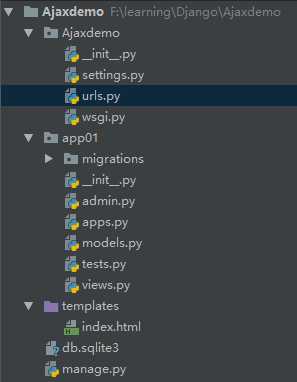标签:open cts 代码 res ssd filter 需要 决定 input框
向服务器发送请求的途径:
1. 浏览器地址栏,默认get请求
2. form表单:
get请求;
post请求
3. a标签,默认get请求
4. Ajax:get请求;post请求
Ajax的特点(记住):
(1) 异步请求
(2)局部刷新
AJAX(Asynchronous Javascript And XML)翻译成中文就是“异步Javascript和XML”。即使用Javascript语言与服务器进行异步交互,传输的数据为XML(传输的数据不只是XML,现在更多使用json数据)。
基于Jquery的Ajax实现
目录结构:

urls.py
from django.contrib import admin from django.urls import path from app01 import views urlpatterns = [ path(‘admin/‘, admin.site.urls), path(r"index/",views.index), path(r"test_ajax/",views.test_ajax) # ajax的路径需要有流程线(如,路由分发的路径,视图函数,页面等) ]
views.py
from django.shortcuts import render,HttpResponse # Create your views here. def index(request): return render(request,"index.html") def test_ajax(request): return HttpResponse("hello world")
index.html
<!DOCTYPE html> <html lang="en"> <head> <meta charset="UTF-8"> <title>Title</title> <script src="https://cdnjs.cloudflare.com/ajax/libs/jquery/3.2.1/jquery.min.js"></script> </head> <body> <h2>this is Index</h2> <button class="ajax">Ajax</button> <p class="content"></p> </body> <script> $(".ajax").click(function () { $.ajax({ {# ajax请求的url;IP的端口没写就默认为当前的 #} url:"/test_ajax/", {# 请求方式;默认get #} type:"get", {#回调函数#} success:function (data) { $(".content").html(data) } }) }) {# 上述Ajax流程:点击button按钮,通过ajax向 特定的url发送请求;服务器返回字符串 "hello world"并传给回调函数的形参 data;回调函数决定怎么在页面上展示data #} </script> </html>
Ajax传递数据:通过 data:{ } 的形式 发送数据
urls.py
from django.contrib import admin from django.urls import path from app01 import views urlpatterns = [ path(‘admin/‘, admin.site.urls), path(r"index/",views.index), path(r"plus/",views.plus) ]
index.html
<!DOCTYPE html> <html lang="en"> <head> <meta charset="UTF-8"> <title>Title</title> <script src="https://cdnjs.cloudflare.com/ajax/libs/jquery/3.2.1/jquery.min.js"></script> </head> <body> <input type="text" class="val1">+<input type="text" class="val2">=<input type="text" class="val3"> <button class="cal">计算</button> </body> <script> $(".cal").click(function () { $.ajax({ url:"/plus/", type:"post", {#ajax的input中不需要添加 name 属性,只需要 class或id 能找到它就行;但form表单需要利用 name属性去取值#} data:{ {# input框中的值是字符串格式 #} "val1":$(".val1").val(), "val2":$(".val2").val() }, success:function (data) { $(".val3").val(data) } }) }) </script> </html>
views.py
from django.shortcuts import render,HttpResponse def plus(request): print(request.POST) val1 = request.POST.get("val1") val2 = request.POST.get("val2") val3 = int(val1) + int(val2) return HttpResponse(val3)
注:settings.py MIDDLEWARE 中的 ‘django.middleware.csrf.CsrfViewMiddleware‘ 需要注释掉
基于Ajax的登陆验证(跨语言的Json)
目录结构同上;settings.py 也注释掉 csrf
urls.py
from django.contrib import admin from django.urls import path from app01 import views urlpatterns = [ path(‘admin/‘, admin.site.urls), path(r"index/",views.index), path(r"login/",views.login) ]
views.py
from django.shortcuts import render,HttpResponse from app01.models import User def login(request): print(request.POST) user = request.POST.get("user") psw = request.POST.get("psw") user_obj = User.objects.filter(name=user,psw=psw).first() res = {"user":None,"msg":None} if user_obj: # 能在数据库中匹配出来 res["user"] = user_obj.name else: res["msg"] = "用户名密码错误" # 字典格式的数据类型不能直接发送,需要先转化为字符串格式 import json # 利用json.dumps()序列化 return HttpResponse(json.dumps(res))
index.html
<!DOCTYPE html> <html lang="en"> <head> <meta charset="UTF-8"> <title>Title</title> <script src="https://cdnjs.cloudflare.com/ajax/libs/jquery/3.2.1/jquery.min.js"></script> </head> <body> {#form表单的action也没必要写,其实form标签也没必要;只是习惯上把form控件标签放到form中#} <form> 用户名 <input type="text" class="user"> 密码 <input type="password" class="psw"> {# 用ajax发请求时 input的type用"button",不要用"submit",否则就变成了form表单发送请求 #} <input type="button" value="submit" class="login_btn"><span class="error"></span> </form> </body> <script> {# 登陆验证 #} $(".login_btn").click(function () { {# 把ajax内置在某个事件中 #} $.ajax({ url:"/login/", type:"post", data:{ "user":$(".user").val(), "psw":$(".psw").val() }, success:function (data) { console.log(data) {# 此时data为json字符串格式 #} console.log(typeof data) {# 此时data这个字符串交给JS去处理了;就需要用JS的反序列化方法 #} {# 只要该语言支持json接口,它就能反解成自己支持的数据类型:python的字典会反解成JS的对象({}),python的列表会反解成JS的数组([])#} {# JSON.parse()是JS的反序列化方法 #} var new_data = JSON.parse(data) console.log(new_data) console.log(typeof new_data) if (new_data.user){ {# location.href= 表示前端跳转 #} location.href="https://www.baidu.com" }else { $(".error").html(new_data.msg).css({"color":"red","margin-left":"10px"}) } } }) }) </script> </html>
文件上传:
请求头ContentType:
ContentType指的是请求体的编码类型,常见的类型共有3种:
1. application/x-www-form-urlencoded:这应该是最常见的 POST 提交数据的方式了。浏览器的原生 <form> 表单,如果不设置 enctype 属性,那么最终就会以 application/x-www-form-urlencoded 方式提交数据。请求类似于下面这样
POST http://www.example.com HTTP/1.1 Content-Type: application/x-www-form-urlencoded;charset=utf-8 user=yuan&age=22
2. multipart/form-datamultipart/form-data:这又是一个常见的 POST 数据提交的方式。我们使用表单上传文件时,必须让 <form> 表单的 enctype 等于 multipart/form-data
3. application/json:Json格式的字符串作为请求头
基于form表单的文件上传
urls.py
from django.contrib import admin from django.urls import path from app01 import views urlpatterns = [ path(r"file_put/",views.file_put) ]
views.py
from django.shortcuts import render,HttpResponse def file_put(request): if request.method == "POST": # 1. 基于form表单的文件上传 print(request.POST) # request.POST 只有在 contentType = urlencoded 时候才有数据 # 注意:上传成功的文件放在 request.FILEs 这个属性里面 print(request.FILES) # 下载所上传的文件 file_obj = request.FILES.get("avatar") # 文件对象有一个属性 .name 表示文件名 with open(file_obj.name,"wb") as f: for line in file_obj: f.write(line) return HttpResponse("ok") return render(request,"file_put.html")
file_put.html
<!DOCTYPE html> <html lang="en"> <head> <meta charset="UTF-8"> <title>Title</title> <script src="https://cdnjs.cloudflare.com/ajax/libs/jquery/3.2.1/jquery.min.js"></script> </head> <body> <h3>基于form表单的文件上传</h3> 注意:上传文件的form表单中要写上 enctype="multipart/form-data" <form action="" method="post" enctype="multipart/form-data"> 用户名 <input type="text" name="user"> 上传文件 input的type属性值是 "file" 头像 <input type="file" name="avatar"> <input type="submit"> </script> </html>
利用Ajax上传普通数据
views.py
from django.shortcuts import render,HttpResponse def file_put(request): if request.method == "POST": return HttpResponse("ok") return render(request,"file_put.html")
file_put.html
<!DOCTYPE html> <html lang="en"> <head> <meta charset="UTF-8"> <title>Title</title> <script src="https://cdnjs.cloudflare.com/ajax/libs/jquery/3.2.1/jquery.min.js"></script> </head> <body> <h3>基于Ajax的文件上传</h3> {# 利用Ajax上传普通数据 #} <form action="" method="post"> 用户名 <input type="text" name="user"> <input type="button" class="btn" value="Ajax"> </form> </body> <script> {#利用Ajax上传普通数据 #} $(".btn").click(function () { $.ajax({ {#url不写默认为当前路径#} url: "", type: "post", {#不指定enctype,默认用application/x-www-form-urlencoded #} data: { a: 1, b: 2 }, success: function (data) { console.log(data) } }) }) {#不论是form表单还是Ajax都有一个默认的请求头 application/x-www-form-urlencoded #} </script> </html>
Ajax传递Json数据
views.py
from django.shortcuts import render,HttpResponse def file_put(request): if request.method == "POST": # 3. Ajax传递Json数据 print("request.body",request.body) # request.body:请求报文中的请求体(请求体的源数据); # request.body b‘{"a":1,"b":2}‘ # 此数据可通过python的json.dumps()方法获取 print("request.POST",request.POST) # 此时 request.POST 中没有数据 # request.POST <QueryDict: {}> return HttpResponse("ok") return render(request,"file_put.html")
file_put.html
<!DOCTYPE html> <html lang="en"> <head> <meta charset="UTF-8"> <title>Title</title> <script src="https://cdnjs.cloudflare.com/ajax/libs/jquery/3.2.1/jquery.min.js"></script> </head> <body> {#Ajax传递Json数据#} <form action="" method="post"> 用户名 <input type="text" name="user"> <input type="button" class="btn" value="Ajax"> </form> </body> <script> {#Ajax传递Json数据#} $(".btn").click(function () { $.ajax({ {#url不写默认为当前路径#} url:"", type:"post", {#告诉服务器编码类型为json数据#} contentType:"application/json", {#然后需要用JS的方法把数据变成Json数据类型:JSON.stringify():序列化 #} {#然后请求体中的数据就是 {"a":"1","b":"2"} 类型的json字符串 #} data:JSON.stringify({ a:1, b:2 }), success:function (data) { console.log(data) } }) }) </script> </html>
基于Ajax的文件上传
from django.shortcuts import render,HttpResponse def file_put(request): if request.method == "POST": # 4. 基于Ajax的文件上传 print("request.body", request.body) print("request.POST", request.POST) print(request.FILES) # 下载所上传的文件 file_obj = request.FILES.get("avatar") # file_obj = request.FILES.get("avatar") # 文件对象有一个属性 .name 表示文件名 with open(file_obj.name,"wb") as f: for line in file_obj: f.write(line) return HttpResponse("ok") return render(request,"file_put.html")
file_put.html
<!DOCTYPE html> <html lang="en"> <head> <meta charset="UTF-8"> <title>Title</title> <script src="https://cdnjs.cloudflare.com/ajax/libs/jquery/3.2.1/jquery.min.js"></script> </head> <body> {# 基于Ajax的文件上传 #} <form action="" method="post"> 用户名 <input type="text" class="user"> 上传文件 input的type属性值是 "file" 头像 <input type="file" class="avatar"> <input type="button" class="btn" value="Ajax"> </form> </body> <script> {# 基于Ajax的文件上传 #} $(".btn").click(function () { {#涉及到文件上传,一定要用 FormData 创建一个新的对象(formdata编码);固定格式 #} var formdata = new FormData(); {#然后给创建的 formdata对象添加键值:append(key,value)方法 #} formdata.append("user",$(".user").val()); formdata.append("avatar",$(".avatar")[0].files[0]); {#$(".avatar")[0]是对应的 input 标签,DOM元素;取DOM元素中包含的文件对象: .files[0],固定语法 #} $.ajax({ {#url不写默认为当前路径#} url:"", type:"post", {#传formdata的时候一定要加上 contentType:false,processData:false, 这两句代码 #} {# contentType:false 表示不做编码处理 #} contentType:false, {#processData:false表示不对数据做预处理#} processData:false, {#把formdata赋值给data#} data:formdata, success:function (data) { console.log(data) } }) }) </script> </html>
标签:open cts 代码 res ssd filter 需要 决定 input框
原文地址:https://www.cnblogs.com/neozheng/p/9170347.html